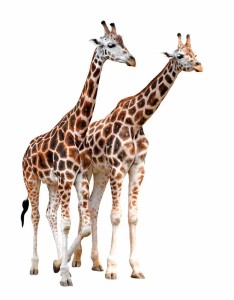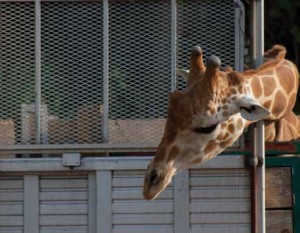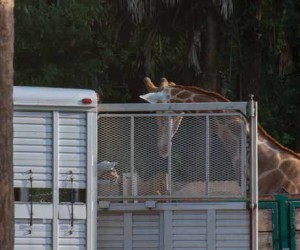A Big Day for Giraffes
by Tim L. Tetzlaff
Director of Conservation & Communications | Naples Zoo at Caribbean Gardens
 It’s a common lot in life. An ordinary day for one person can be a watershed moment in the life of another. And so it was on a recent spring morning when you may have been settling in to work or mulling over your plans for the day. And even here at the Zoo, the casual observer could see the routine of the regular walkers exercising in the gardens and early guests sipping coffee in the pavilion. But for the animal care staff, this morning represented the culmination of years of devotion for the survival of an iconic African species as one of our seven giraffes was destined to leave the herd.
It’s a common lot in life. An ordinary day for one person can be a watershed moment in the life of another. And so it was on a recent spring morning when you may have been settling in to work or mulling over your plans for the day. And even here at the Zoo, the casual observer could see the routine of the regular walkers exercising in the gardens and early guests sipping coffee in the pavilion. But for the animal care staff, this morning represented the culmination of years of devotion for the survival of an iconic African species as one of our seven giraffes was destined to leave the herd.
Locally, the story began back in 2009 as we were finalizing plans to welcome giraffes to Naples and began seeking keepers with expertise in caring for these giants. Looking over the needs for the giraffe population outside the wild, it became clear there was a need for more zoos to have bachelor herds, a social structure giraffes form in the wild.
Over the next year, we began assembling an all-male herd spanning the continent from San Francisco Zoo and Denver Zoo in the West to Lion Country Safari and Disney’s Animal Kingdom in the East.
 But an all boys’ club was never the end game. That’s because these giraffes are part of the Reticulated and Rothschild Giraffe Species Survival Plan® (SSP), a cooperative conservation effort among zoos accredited by the Association of Zoos and Aquariums (AZA). Just like in the wild where males will leave the bachelor herds to seek out female company, bachelor herds in zoos will send out some males for breeding. In zoos, these moves are scientifically analyzed by an SSP coordinator using custom software that includes the extensive ancestry records of all the giraffes in North America to insure the healthiest genetic herd for long-term survival.
But an all boys’ club was never the end game. That’s because these giraffes are part of the Reticulated and Rothschild Giraffe Species Survival Plan® (SSP), a cooperative conservation effort among zoos accredited by the Association of Zoos and Aquariums (AZA). Just like in the wild where males will leave the bachelor herds to seek out female company, bachelor herds in zoos will send out some males for breeding. In zoos, these moves are scientifically analyzed by an SSP coordinator using custom software that includes the extensive ancestry records of all the giraffes in North America to insure the healthiest genetic herd for long-term survival.
And this time, the SSP recommendation was for our giraffe Jigsaw to move away from the bachelor herd. Jigsaw was born at Lion Country Safari in Loxahatchee and has spent the last five years with us in Naples. And this native Floridian would continue his life in the state as he was set to meet a herd of six females at White Oak Conservation Center in northern Florida. With limited public access, this AZA-certified facility is little known to the average citizen, but well known among the zoological community for their successes including rehabilitating orphaned Florida panthers that have been released back into the wild.
 As you can imagine, transporting a giraffe is a bit different than taking your dog for a ride in the car. Giraffes are far more cautious and don’t respond with the same enthusiasm to an excited call of “Who wants to go for a ride!” so training was implemented for the big day.
As you can imagine, transporting a giraffe is a bit different than taking your dog for a ride in the car. Giraffes are far more cautious and don’t respond with the same enthusiasm to an excited call of “Who wants to go for a ride!” so training was implemented for the big day.
For their daily monitoring as well as veterinary care, our giraffes are already trained to move through a chute where keepers have different height access points to get an up close look from hoof to horn (technically not horns, but ossicones, but I digress). On moving day, a custom giraffe trailer would be waiting at the end of this chute to take him to his new herd. To prepare him, staff began regularly backing up one of the zoo’s smaller hoofstock trailers while he was in the chute.
While he responded beautifully, the moment of truth would come when he would be asked to walk into the real transport trailer.
Wonderfully, zoological facilities have a network of professional transporters we use and each has their specialty – including some that move the world’s tallest animal. Besides custom equipment, knowledge of the species is key. And when it comes to moving a giraffe that must include patience – sometimes all-day patience. Gratefully, not much was needed with Jigsaw. With his keepers nearby and encouraging him, he looked over the trailer and gave some careful sniffs. In an hour, he casually walked inside and turned around and nibbled some leaves.
 “As his care takers for the past few years, we were sad to say goodbye to Jigsaw. Yet moves like this are reminders of how we contribute to the broader mission of ensuring that giraffes are around for our grandchildren to appreciate,” said Naples Zoo’s Director of Animal Programs Liz Harmon. Yet even as keepers teared up, our six other giraffe moved normally about their daily business – a gentle reminder of the differences between our two worlds.
“As his care takers for the past few years, we were sad to say goodbye to Jigsaw. Yet moves like this are reminders of how we contribute to the broader mission of ensuring that giraffes are around for our grandchildren to appreciate,” said Naples Zoo’s Director of Animal Programs Liz Harmon. Yet even as keepers teared up, our six other giraffe moved normally about their daily business – a gentle reminder of the differences between our two worlds.
There are also two worlds between living here and in the wild.
While Jigsaw lives in peace, his giraffe relatives in Africa have suffered greatly. Although we adore these gentle giants, they face indirect threats from pastoralists degrading habitat and introducing new diseases. Agriculture fragments and outright eliminates the places they live.
For perspective, the number of Jigsaw’s reticulated giraffe cousins plummeted from about 30,000 to as few as 5,000 in just over a decade.
And direct threats are even more heartbreaking. The giraffe population in the Democratic Republic of the Congo has violently crashed to between 30 and 40 individuals at the gun points of Joseph Kony’s LRA rebels whose AK-47s and machetes reduce these majestic creatures into common dinner meat.
The free fall in wild populations makes it critically important to have protected populations in accredited zoos. In concert with breeding programs, zoos are ideally suited to powerfully share the challenges facing this beloved species with millions of people and provide proven ways for caring people to make a difference for the giraffes in both worlds.
To realize ways in which people and giraffes can coexist in nature, Naples Zoo supports the Giraffe Conservation Foundation. These funds assist efforts like their Executive Director Dr. Julian Fennessy’s recent Congo visit to orchestrate a plan for saving these few survivors. (You can see Dr. Fennessy with our giraffe talking about these issues in a video at www.napleszoo.org/giraffe.)
As he pulled away through the gate, Jigsaw would enjoy a smooth ride on this special day. And by the evening, staff at his new home gave word that he was already nuzzling with the females in his new herd. At sunrise, Jigsaw would see his new home in the light of day while we envisioned a future day where all giraffe can still stand tall.
Far from the simple menageries of past, today’s nationally accredited zoos are centers of learning and natural crossroads for biologists, educators, environmental scientists, and researchers – as well as for students, conservationists, and all animal lovers. Naples Zoo at Caribbean Gardens is a trusted, private 501(c)(3) nonprofit serving wildlife and families here and around the world. To learn more about how you can help giraffes, email Naples Zoo’s Director of Conservation at tim@napleszoo.org.

Leave a Reply
Want to join the discussion?Feel free to contribute!